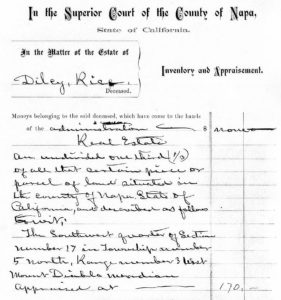By JOSEPH & JUDIE PALMER
Special to the Gazette
From our last column, we wrote about Aaron’s horrible heartbreak with the loss of his entire family outside of his son Nathaniel in less than a year. It started with the death of his father Rev. Robert Rice (75) on March 20, 1875 from dropsy. Followed by his daughter-in-law Rebecca (21) November 1, 1875 from consumption, mother Dilcy (84) February 16, 1876 from “old age”, and finally with his wife Charlotte (64) on March 3, 1876 from typhoid fever. However, on October 31, 1877 Nathaniel (31) marries Edward Hatton’s stepdaughter Annie Elizabeth Dyer (27) returning much joy back to their lives.
We ended our column with a tease regarding Dilcy’s probate. At that time, probate filings had a grace period of four years from date of death to resolve estates where no will was formally filed, or found. Aaron hired attorney Andrew Jackson Hall to file his mother’s probate on January 17, 1880 only after he sold his interest in the 160-acre family farm for $1,000 to Manual Lucas on the same day. Presumably this was to have the money needed to cover the costs associated with his mother’s probate. Fortunately, Aaron did not have to also file a probate for Charlotte, as she no longer had property under her name.
As with any probate, it is a drawn out process that takes some time to complete. A. J. Hall first files Aaron’s “Petition for Letters of Administration” on January 19, 1880, whereupon a hearing is set for February 2 at 10 am. Within his petition, Aaron states that he is the only child of Dilcy’s and her estate is made up of the 1/3 portion of the 160-acre family farm worth a maximum of $150 which garners an annual profit of $20. At the hearing, Superior Court Judge William C. Wallace orders Aaron Rice to become administrator for Dilcy’s estate upon the receipt of a $100 bond, which is issued the same day. His attorney acted as witness along with Thomas M. Brown and Bartolomeo Semorile who signed as guarantors.
It should be noted that Aaron, who we know was illiterate prior to these filings, signs his actual name where required. As the proceedings move along his signature vastly improves by the end.
The “Instructions to Administrators” given to Aaron were as follows: “1st. When you have received your letters take immediate possession of all property, and collect debts due to the estate.” “2nd. File an inventory and appraisement as soon as possible.” “3rd. Give notice to creditors by publication immediately.” “4th. After notice to creditors has been given, file copy thereof with affidavit of publication.” “5th. Pay no debt or claim on the estate until it has been presented, allowed, filed and ordered paid by the Court.” “6th. Sell no property, real or personal, without an order of the Court.” “7th. At the third term of the Court from your appointment,… render an Exhibit under oath.” “8th. Within thirty days after the expiration of the time mentioned in your notice to creditors, in which claims must be exhibited, render a full account and report of your administration to the court.” “9th. Upon the settlement of your account obtain an order of the Court for the payment of the debts which have been allowed.” “10th. All costs incurred by reason of your neglect to comply with your duty, and in enforcing such compliance, will be charged to you, and not to the estate.”
On February 3, the “Order Appointing Appraisers” (listing Louis Bruck, Thomas Jefferson DeWoody, and Erwin Samuel Gridley as the appraisers) and the “Order of Publication and Notice to Creditors” (requiring a weekly published newspaper notice for four consecutive weeks) were filed. Creditors were given four months from date of first notice to come forward.

On February 6, the estate’s appraisal listed only the land valued at $170. Following instructions, Aaron published a notice from February 7 through March 6 in the Napa Register, which they confirmed on March 30. The “Proof of Publication and Notice to Creditors” filed April 12 was followed by the decree, “Due and Legal Notice to Creditors has been Given”, on July 15 and a final accounting on Aug 2, which listed simply: Cash Received $10 from Rents; Cash Expenditures – Clerk Fees $8.50, Publication Fees $4.60, totaling $13.10; Estate appraisal $170 ($3,761.21 today). Including the $100 bond and the $10 clerk fees for registering the sale of the farm to Lucas, Aaron spent a total of $123.10 ($2,723.56 today) not including his attorney fees.
On August 4 an “Affidavit to Forgoing Account” (in which Aaron stipulates that there are no other debts and all accounts have been settled) followed by the “Petition for Distribution of Estate” are filed. Again he states he is 58 and Dilcy’s only child. He further stipulates that the estate is ready to be closed. An “Order appointing day for Settlement of Account and Directing Notice to be Given” is issued for Tuesday August 17, at 10 am. The notice was immediately posted by Henry Brown at the Wells Fargo Co. & Express offices, the Courtroom and outside the Courthouse and sworn to on August 9.
After a “Final Decree of Settlement of Final Account by Administrator” is filed reiterating everything that has transpired prior, the “Decree of Distribution of Estate” is finally issued at the distribution hearing on August 17. Within the document it states, “…And that the said Dilcy Rice died in testate, leaving him surviving Aaron Rice son of deceased aged 60 years, residing in Napa County California, William Rice, son of deceased aged 62 years and Judy Schlesher, daughter of deceased aged 58 years (residence of last named son and daughter unknown) who are entitled to the residue of said estate.”
The authors of this column were stunned to say the least. Was this William Rice, slave owner of Aaron and his family claiming at the last minute he was the son of Dilcy? Was he still holding a grudge? And, who was Judy Schlesher? Upon further research we discovered that Aaron indeed had siblings after all. Judge Wallace’s final distribution order of Dilcy’s estate issued each a third or effectively a ninth of the entire family farm. Since Aaron had already sold his interest to Manual Lucas, that only left William’s and Judy’s portion unsold.
More on his Aaron’s siblings and Nathaniel next as we continue Aaron’s story.
For more information, or to volunteer with the Martinez Historical Society’s – Potter’s Field Restoration Project, please visit our website. Do you have a Potter’s Field resident story to tell? We welcome any pictures or information on anyone or anything regarding Potter’s Field. Please email us at martinezcemetery@gmail.com or call us at (925) 335-9396.
Saturday, May 12 is the first Alhambra Cemetery Cleanup Day and our first Potter’s Field Restoration Project workday of the year sponsored by the City of Martinez, Martinez Historical Society, E. Clampus Vitas, and SOLS. The hours are 9am to 2pm, with E. Clampus Vitas providing lunch and SOLS providing refreshments. While there is plenty of work to do to maintain, preserve, and restore this very important outdoor museum, as the story goes, “many hands make light work”. Come join us and be a part of our ever growing volunteer community as a good time is had by all! Lastly and for good measure it’s a chance to visit the site and inspiration behind our columns.
Martinez Museum – 1005 Escobar Street, and corner of Court Street. Open Tues and Thurs 11:30 a.m. to 3p.m. First 4 Sundays 1-4 p.m. 925-228-8160; www.martinezhistory.org.


